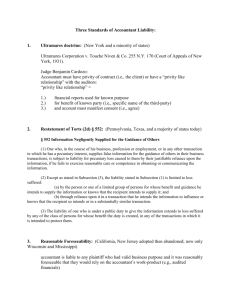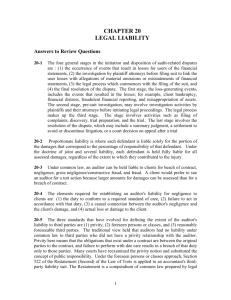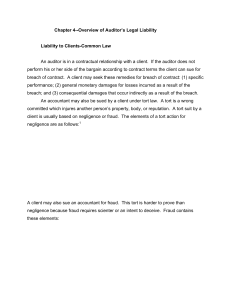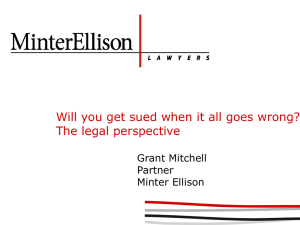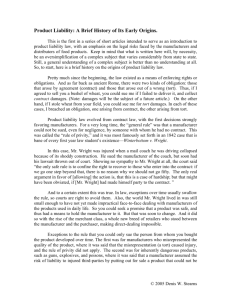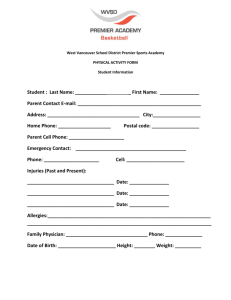Chapter 4--Overview of Auditor's Legal Liability Liability to Clients
advertisement
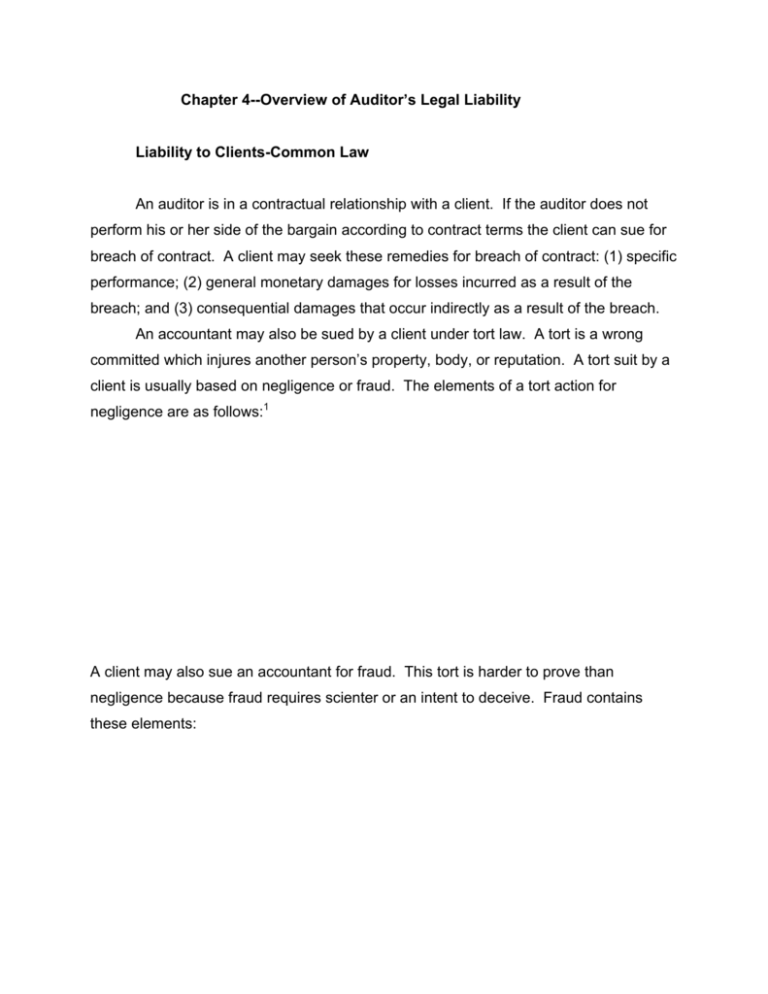
Chapter 4--Overview of Auditor’s Legal Liability Liability to Clients-Common Law An auditor is in a contractual relationship with a client. If the auditor does not perform his or her side of the bargain according to contract terms the client can sue for breach of contract. A client may seek these remedies for breach of contract: (1) specific performance; (2) general monetary damages for losses incurred as a result of the breach; and (3) consequential damages that occur indirectly as a result of the breach. An accountant may also be sued by a client under tort law. A tort is a wrong committed which injures another person’s property, body, or reputation. A tort suit by a client is usually based on negligence or fraud. The elements of a tort action for negligence are as follows:1 A client may also sue an accountant for fraud. This tort is harder to prove than negligence because fraud requires scienter or an intent to deceive. Fraud contains these elements: A material fact is one that a reasonable person would consider important in deciding whether to act. Also, an accountant may be held liable for gross negligence by a client. Gross negligence does not require scienter but necessitates proof of reckless disregard of the truth or one’s duties. Gross negligence is referred to by some as constructive fraud. No legal question arises about a client’s right to sue (i.e., standing to sue) because the client and accountant are in privity. Privity refers to the existence of a direct connection or contractual relationship between parties. A client may sue an accountant for breach of fiduciary duty. A fiduciary relationship is usually considered to exist between two persons when one of them is under a duty to act or give advice for the benefit of another upon matters within the scope of the relation. It is well settled that in most engagements except an audit, a CPA is a fiduciary. Any non-audit services are quite likely to result in a finding of a fiduciary relationship. The burden is on the fiduciary to prove there was no violation of a fiduciary obligation. The elements of proof for a claim of breach of fiduciary duty are: Proof of reliance is not required. Conflicts of interest that may be a breach of fiduciary duty: Another area of concern for accountants is deceptive trade practice statutes. These statutes vary considerably from state to state. Some relate to professional services and others do not. The Texas Deceptive Trade Practices Act led to a number of verdicts against accountants before it was amended to exclude claims for professional services. This exclusion does not appear to apply to tax return preparation or bookkeeping. Courts in Illinois, Massachusetts, Minnesota, and New Jersey have held that their statutes apply to accountants. While audit failures cause the largest losses for the Big 5 firms, tax practice errors cause more losses than any other category for smaller accounting firms. Depending on the facts and circumstances any one of the following standards of care may apply to tax practice: Generally, the statute of limitations is generally the most important defense for tax malpractice claims. Suit cannot be filed prior to the time the malpractice claim accrues. Accrual of a claim for tax malpractice may depend upon whether: Liability to Third Parties--Common Law Nonclients can sue an accountant for fraud. Privity is not necessary. Keep in mind that fraud is based on state, not federal law. Negligence and/or negligent misrepresentation are also questions of state, not federal law. Many courts, textbooks, articles and CPA exam materials use the terms “negligence”and “negligent misrepresentation” as synonyms or like-terms. So we will use these two terms interchangeably. Negligent misrepresentation evolved from the tort of deceit. The necessary elements are:2 Actually, four main approaches or rules have been used by state courts to decide which nonclients are owed a duty by accountants. These four competing rules are: privity, near privity, the known-users or foreseen users or Restatement standard and the foreseeability approach. Your textbook lumps the privity and near-privity approaches together. The four rules are not discrete points but lie on a continuum. Variations exist within each of the four schools of thought. Privity and Near-Privity Approaches The first American case decided on the issue of accountant liability to third parties was Landell v. Lybrand.3 In that case, Lybrand Ross Bros. & Montgomery, CPAs, audited the books of the Employers’ Indemnification Company. Plaintiff Landell claimed that he bought 11 shares of common stock in reliance on the defendant CPAs’ report on Employers’ balance sheet. The stock subsequently became worthless. The Supreme Court of Pennsylvania ruled that Landell could not sue the CPAs (for negligence) due to a lack of privity. Any cogent examination of third-party liability based on negligent misrepresentation includes Judge Cardozo’s opinion in Ultramares Corporation v. Touche.4 In early 1924, Touche, Niven & Co., CPAs, were engaged to audit the balance sheet of Fred Stern & Co., a rubber importer, for fiscal year end 1923. Touche provided the Stern firm with 32 copies of the certified balance sheet in March, 1924, knowing that the audited balance sheet would be shown to various creditors and stockholders. Ultramares, a factoring business, made numerous loans to Stern & Co. in reliance on the audited balance sheet. In January, 1925, Stern & Co. went bankrupt. In addressing the plaintiff’s claim of negligence against Touche, Cardozo wrote: If liability for negligence exists, a thoughtless slip or blunder, the failure to detect a theft or forgery beneath the cover of deceptive entries, may expose accountants to a liability in an indeterminate amount for an indeterminate time to an indeterminate class. The hazards of a business conducted on these terms are so extreme as to enkindle doubt whether a flaw may not exist in the implication of a duty that exposes to these consequences.5 The New York Court of Appeals denied the plaintiff’s negligence claim. The New York Court of Appeals did not require Ultramares to be in privity with Touche to hold Touche liable for negligent misrepresentation. The Court fashioned an exception to privity that has become known as the primary benefit rule (i.e. the plaintiff must be an intended third-party beneficiary). Overly rigorous interpretations of Ultramares over the years have resulted in the case symbolizing a privity requirement for recovery under negligent misrepresentation.6 As of the early 1930s, only privity of contract and the primary benefit rule existed for the determination of the scope of an auditor’s third-party duty. New York addressed the issue again in 1985 in Credit Alliance v. Arthur Andersen & Co.7 Credit Alliance Corporation, a financial services firm, provided equipment financing to L.B. Smith, Inc. for many years. In 1978, Credit Alliance Corp. advised Smith that any future extensions of credit would require audited financial statements. Smith provided Credit Alliance with its consolidated financial statements, including an unqualified opinion from Arthur Andersen, for the fiscal years 1976 through 1979. In 1980, L.B. Smith , Inc. filed for bankruptcy. After a judicial analysis of certain court opinions, the Court of Appeals clarified the legal standard for a plaintiff to recover for negligent misrepresentation. The legal test includes these elements: (1) the auditors must have been aware that the financial reports were to be used for a particular purpose or purposes; (2) in the furtherance of which a known party or parties was(were) intended to rely; and (3) there must have been some conduct on the part of the auditors linking them to that party or parties, which evinces the auditors’ understanding of that party or parties’ reliance.8 Affirmative conduct linking auditors to the relying party is a requirement that makes the Credit Alliance test at least as, if not more, restrictive than Ultramares (though they are both near privity rules). The Known-Users or Restatement Approach Until 1968, the privity and primary benefit rules were the only two approaches to accountant liability to nonclients for negligence. In 1968, the first serious blow to these two legal rules was delivered in Rusch Factors v. Levin.9 The federal district court in Rhode Island held that auditors should be liable in negligent misrepresentation for financial misinformation relied upon by actually foreseen and limited classes of persons. The District Court actually applied section 552 of the Restatement (Second) of Torts, a compendium of the law drafted by the American Law Institute. Under the Restatement standard, an auditor who audits or prepares financial information for a client: The major difference between the primary benefit rule of Ultramares and Restatement section 552 is that the Restatement does not require that the identity of specific parties be known to the auditor, only that they be members of a limited group known to the auditor. Foreseeability Approach In 1983, the expansion of auditor liability to nonclients continued with the decision in Rosenblum v. Adler.10 (This case ceased to be effective in N.J. in March, 1995 upon enactment of an accountant liability statute.) Investors Harry and Barry Rosenblum sued Touche Ross, auditor for Giant Stores, pursuant to a sale of their business to Giant. Touche furnished the audited financial statements for Giant’s SEC registration statement for a 1972 securities offering and rendered an unqualified opinion for each of the five fiscal years 1968 through 1972. Giant management had “cooked its books” by falsely recording assets not owned and omitting significant accounts payable in 1971 and 1972. Giant filed for bankruptcy in 1973. The New Jersey Supreme Court concluded that an auditor has a duty to all those whom the auditor should reasonably foresee as receiving and relying on the audited statements. However, the duty extends only to those users whose decision is influenced by audited statements obtained from the audited entity for a proper business purpose. This principle implies that “the auditor owes a duty of care to all who obtain a firm’s financial statement directly from the audited entity, but owes no such duty of care to those who obtain it from an annual report in a library, or from a government file.”11 The Rosenblum decision widened accountants’ liability for negligence and represented, in many cases, the extreme to which an accountant’s duty to nonclients had been extended for negligent misrepresentation. Today the only two states which follow the reasonably foreseeable users’ rule are Wisconsin and Mississippi. Emergence of a Trend Toward a Narrower Scope of Liability The emergence of a trend toward a narrower scope of liability (to nonclients for negligence) began in the mid- to late-1980s. The trend consists of twenty-six states which have either rejected the reasonable foreseeability rule, adopted the Restatement, Credit Alliance, Ultramares, or privity rule or enacted an accountant liability statute. Alabama is the only state that has widened the scope of an accountant’s duty to third parties during the last 15 years. The process was started in 1986 when Illinois passed an accountant liability statute. Statutory Jurisdictions. Since 1986, eight states--Arkansas, Illinois, Kansas, Louisiana, Michigan, New Jersey, Utah and Wyoming--have enacted statutes which address accountants’ liability to nonclients for negligence. Figure 1 illustrates that statutes have a narrower scope of duty than the Restatement but a wider scope of duty than the privity rule. All eight statutes reduce the probability of a miscommunication or misunderstanding between the accountant, client, and third party. The writing requirement in these states “provides more certainty because the third party knows before reading a financial statement whether he can recover from the auditor....”12 Statutory Liability (Federal) The two most important federal statutes affecting auditors are the Securities Act of 1933 and the Securities Exchange Act of 1934. Both of these statutes are available for clients and third parties. The Securities Act of 1933 regulates the disclosure of material facts in the registration statement and prospectus as part of a new offering of securities to the public. A registration statement contains information and documents that must be filed with the SEC, such as capital structure, description of management and the business enterprise, and financial statements certified by independent public accountants. A prospectus is a document created by a securities issuer setting forth the nature and objects of an issue of securities and inviting the public to subscribe to the issue. Section 11 of the 1933 Act imposes civil liability on any party, including auditors, who prepare or certify any portion of a registration statement that contains materially misleading information. A purchaser of a security must only show that a loss has been suffered on the security. Reliance upon a materially false statement or misleading omission need not be proved. Privity between the purchaser and auditor is not necessary. In stating a section 11 claim, a plaintiff need not prove fraud, gross negligence, causation or intent to deceive to recover. After the purchaser demonstrates a loss, the burden of proof shifts to the auditor to show that he had “after reasonable investigation, reasonable grounds to believe and did believe, at the time such part of the registration statement became effective, that the statements therein were true and that there was no omission of a material fact....”13 This is the burden of proving due diligence by the accountant. An auditor may also raise as defenses that: Section 12 of the Securities Act of 1933 consists of two parts, section 12(1) and 12(2). Section 12(1) imposes civil liability on anyone who violates the registration requirements of the SEC. Section 12(2) applies to any person who offers or sells securities by means of any prospectus containing an untrue statement of a material fact. It also applies to the omission of a material fact necessary in order to make a prospectus, in the light of the circumstances under which the prospectus is provided, not misleading. Section 12 covers the same kind of misleading information as does section 11, but looks to the offending prospectus, rather than the offending registration statement, for its application. The principal auditor liability provisions of the Securities Exchange Act of 1934 are sections 10 and 18. Liability under section 18 is narrow because it relates only to applications, reports, documents, and registration statements filed with the SEC. Shareholders’ annual reports are not considered to be filed with the SEC unless included in an SEC filing. Also, section 18 applies only to buyers and sellers of securities. A buyer or seller filing a section 18 claim must demonstrate: An auditor can be relieved of liability upon proof of good faith. This means that the minimum standard for auditor liability under section 18 is gross negligence. The most frequently employed statute in securities litigation against auditors is section 10(b) (or Rule 10b-5) of the Securities Exchange Act of 1934. The courts have implied a private right of action under section 10(b) applicable to any transaction involving the sale or exchange of a security. A seller or purchaser of a security must prove the following elements to recover under section 10(b): Privity is not required to bring an action under section 10(b). The requirement of scienter means that mere negligence on the part of the auditor is insufficient to impose liability under section 10(b). In Ernst & Ernst v. Hochfelder, the U.S. Supreme Court ruled that a private civil lawsuit will not lie under section 10(b) in the absence of an intent to deceive or at a minimum recklessness or gross negligence. Prior to Hochfelder, several Circuit Courts of Appeal had held that negligence alone was sufficient for civil liability under section 10(b) and Rule 10b-5. Private Securities Litigation Reform Act of 1995 On December 22, 1995, the Private Securities Litigation Reform Act of 1995 became law over Clinton’s veto. The Reform Act is important because it substantially revises the Securities Act of 1933 and the Securities Exchange Act of 1934--acts which have been frequently used as a basis for liability against accounting firms. The intended objective of the reform was to reduce frivolous litigation risk for auditors, publicly traded firms, and parties affiliated with security issuers. Some of the more important provisions of the Reform Act for accountants include: (A) The Securities Exchange Act of 1934 was amended to limit the use of joint and several liability. The imposition of joint and several liability can require one defendant in a lawsuit to pay 100 percent of the damages regardless of the degree of fault. Defendants, such as accountants, who do not intentionally violate the securities laws are responsible only for their share of the judgment. Two exceptions exist: (1) for those plaintiffs who demonstrate they are entitled to damages greater than 10 percent of their net worth (which may not exceed $200,000); and (2) when a defendant is insolvent each of the remaining defendants must pay up to 50 percent of their own liability as damages; (B) A limitation on the damages an accountant can be held liable for under section 10(b) of the Securities Exchange Act of 1934. Traditionally, a plaintiff’s damages were the difference between the purchase price of the security and either (1) the price at which the security was sold or (2) the price of the security when the market has adjusted to public discovery of the alleged misrepresentation.14 The computation of damages in this manner has the potential to overestimate substantially the plaintiff’s actual damages. One amendment to the Securities Exchange Act of 1934 provides that civil damages cannot exceed the difference between the security purchase or sale price and the mean trading price of the security during the 90-day period starting on the date of disclosure of the misstatement or omission; (C) Limitations on discovery proceedings by plaintiffs at the early stages of class action securities lawsuits. In the past, huge discovery costs have led accountants and others to settle frivolous lawsuits to avoid costs; and (D) Any plaintiff bringing an action under section 10(b) must now prove that the accountant’s material misstatement or omission actually caused the plaintiff’s loss. REFERENCES 1. Bily v. Arthur Young & Co.,3 Cal. 4th 370, 834 P.2d 745 (1992). 2. Martens Chevrolet, Inc. v. Seney, 439 A.2d 534 (Md.App. 1982). 3. 264 Pa. 406, 107 A. 783 (1919). 4. 255 N.Y. 170, 174 N.E. 441 (1931). 5. 255 N.Y. 170, 174 N.E. 441, 444 (1931). 6. Gormley, R.J. 1984. The foreseen, the foreseeable, and beyond--accountants’ liability to nonclients. Seton Hall Law Review 14: 528-573. 7. 65 N.Y. 2d 536, 493 N.Y.S. 2d 435, 483 N.E.2d 110 (1985). 8. 65 N.Y. 2d 536, 493 N. Y.S. 2d 435, 483 N.E.2d 110, 118 (1985). 9. 284 F. Supp. 85 (D.R.I. 1968). In that case, a Rhode Island corporation sought financing from Rusch Factors, Inc. in late 1963 and early 1964. Plaintiff Rusch Factors requested audited financial statements from the corporation. The defendant auditor prepared financial statements relied on by the plaintiff. The financial statements indicated the corporation was solvent when it was actually insolvent. Rusch Factors extended about $337,000 in credit to the corporation. Subsequently, the corporation defaulted and went into receivership. 10. 93 N.J. 324, 461 A. 2d 138 (1983). 11. Causey, D. 1987. Accountants’ liability in an indeterminate amount for an indeterminate time to an indeterminate class: an analysis of Touche Ross Co. V. Commercial Union Ins. Co., Mississippi Law Journal 57 (August): 379-416. 12. Fencl, E. 1989. Rebuilding the citadel: state legislative responses to accountant non-privity suits. Washington University Law Quarterly 67 (Fall): 863-888. 13. 15 U.S.C. section 77k(b)(3). 14. Affiliated Ute Citizens v. U.S., 406 U.S. 128, 154-155 (1972); Nelson v. Serwold, 687 F.2d 278, 280-281 (9th Cir. 1982).
